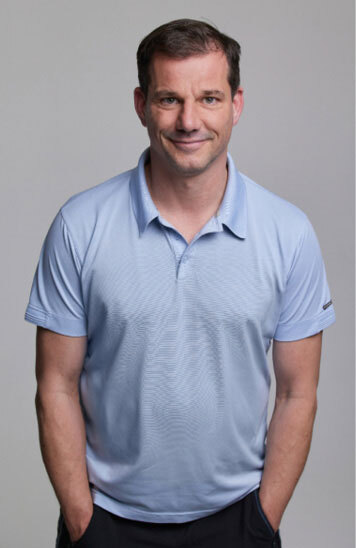Рекомендации по организации ситуативно обусловленных скоростных тренировок
Упражнения для повышения скорости, привязанные к контексту игровых видов спорта, могут составлять содержание отдельной тренировки либо включаться в разминку, а затем выступать в роли компонентов отработки различных технических приемов.
Если упражнения для решения ситуативно обусловленных скоростных задач рассматриваются как самостоятельное тренировочное занятие, то им должны предшествовать и . Кроме того, перед тренировкой реакции и скорости восприятия должна быть проведена подготовка зрительной системы продолжительностью 3–4 минуты. Используйте только те упражнения, которые продемонстрировали положительные результаты в ходе тестирования. Освоение отдельных упражнений может проводиться в составе тренировочных блоков продолжительностью от 4 до 6 недель или включаться в обычные тренировки.

Об авторе

Ларс Линхард – ученый, бывший профессиональный спортсмен, родоначальник нейроатлетики и один из ведущих европейских специалистов по нейроцентрическим тренировкам. Он возглавляет институт, занимающийся вопросами нейроатлетики, работает тренером и консультантом ведущих спортсменов. Им подготовлено значительное количество атлетов для участия в Олимпийских играх и чемпионатах мира. Ларс Линхард оказывает консультационные услуги и помощь спортивным объединениям и федерациям в организации крупных мероприятий. Он был членом тренерского штаба на чемпионате мира по футболу 2014 года в Бразилии, а также на летних Олимпийских играх 2016 года в Рио-де-Жанейро. В 2019 году в издательстве riva вышла его основополагающая книга Training beginnt im Gehirn, а вслед за ней в 2020 году – Kraft beginnt im Gehirn.
Выражение благодарности
Я благодарен своей жене Улле и сыну Лиаму за терпение, любовь и безграничную поддержку. Также выражаю признательность Йоргу Мёккелю за помощь, советы и возможность пользоваться плодами его опыта, без которых эта книга не состоялась бы.
Список использованной литературы
Рекомендуемые книги на английском языке
Bisio, T. (2004): A Tooth from the Tiger’s Mouth: How to Treat Your Injuries with Powerful Healing Secrets of the Great Chinese Warrior. Fireside Books, New York
Bosch, F. (2020): Anatomy of Agility. 20/10 uitgevers, Rotterdam
Hatch, Dr. J. D. (2017): Basis of Brain Rehab. Create Space Independent Publishing Platform
Herdman, S. J.; Clendaniel, R. A. (2014): Vestibular Rehabilitation. 4. Auflage, Jaypee Brothers, Neu-Delhi
Jeffreys I. (2017): Gamespeed: Movement Training for Superior Sports Performance. 2. Auflage, Coaches Choice
Mann, R.; Murphy, A. (2018): The mechanics of sprinting and hurdling. 2018 Edition, CreateSpace Independent Publishing Platform, Lexington, KY
Pennartz, C. M. A. (2015): The Brain’s Representational Power: On Consciousness and the Integration of Modalities. The MIT Press, London
Peters, M. A. (2012): See to Play: The Eyes of Elite Athletes. Bascom Hill, Minneapolis
Smith, M. (2005): High Performance Sprinting. The Crowood Press, Ramsbury
Wilson-Pauwels, L. (2010): Cranial Nerves: Function and Dysfunction. 3. Auflage, People’s Medical Publishing House, Shelton/Connecticut
Рекомендуемые книги на немецком языке
Grosser, M.; Renner, Th. (2007): Schnelligkeitstraining: Grundlagen, Methoden, Leistungssteuerung, Programme für alle Sportarten. BLV Buchverlag
Lienhard, L. (2019): Training beginnt im Gehirn. Mit Neuroathletik die sportliche Leistung verbessern. riva Verlag, München
Lienhard, L. (2020): Kraft beginnt im Gehirn. Mit Neuroathletik die Kraftentfaltung maximieren. riva Verlag, München
Lühnenschloß, D.; Dierks, B. (2005): Schnelligkeit. Hofmann-Verlag, Schorndorf
Mechling, H.; Munzert, J. (2003): Handbuch Bewegungswissenschaft – Bewegungslehre. Hofmann-Verlag, Schorndorf
Meinel, K.; Schnabel, G. (2007): Bewegungslehre Sportmotorik: Abriss einer Theorie der sportlichen Motorik unter pädagogischem Aspekt. Meyer & Meyer Verlag, Aachen
Schmid-Fetzer, U. (2018): Neuroathletiktraining. Grundlagen und Praxis des neurozentrierten Trainings. Pflaum Verlag, München
Schnabel, G.; Harre, D.; Krug, J. (Hrsg.) (2014): Trainingslehre-Trainingswissenschaft: Leistung-Training-Wettkampf. 3. Auflage, Meyer & Meyer Verlag, Aachen
Schöllhorn, W. (2003): Eine Sprint- und Laufschule für alle Sportarten. Meyer & Meyer Verlag, Aachen
Strüder, H. K.; Jonath, U.; Scholz, K. (2017): Leichtathletik: Trainings- und Bewegungswissenschaft – Theorie und Praxis aller Disziplinen. 3. Auflage, Sportverlag Strauß, Hellenthal
Voß, G.; Witt, M.; Werthner, R. (2006): Herausforderung Schnelligkeitstraining. Meyer & Meyer Verlag, Aachen
Weineck, J. (2019): Optimales Training. Leistungsphysiologische Trainingslehre unter besonderer Berücksichtigung des Kinder- und Jugendtrainings. 17., überarbeitete und erweiterte Auflage, Spitta, Balingen
Интересные и важные журнальные публикации
Bramão, I.; Faísca, L.; Forkstam, C.; Reis, A.; Petersson, K. M. (2010): Cortical brain regions associated with color processing: an FMRI study. The Open Neuroimaging Journal, 4(0), S. 164–173
Clark, A. (2013): Whatever Next? Predictive Brains, Situated Agents, and the Future of Cognitive Science. Behavioral and Brain Sciences, 36(3), S. 181–204
Clark, J. F.; Graman, P.; Ellis, J. K.; Mangine, R. E.; Rauch, J. T.; Bixenmann, B.; Meyer, G. D. (2015): An Exploratory Study of the Potential Effects of Vision Training on Concussion Incidence in Football. Optometry & Visual Performance, 3(2), S. 116–125
Deveau, J.; Seitz, A. R. (2014): Applying perceptual learning to achieve practical changes in vision. Frontiers in Psychology, 5(October), S. 1166
Di Vico, R.; Ardigò, L. P.; Salernitano, G.; Chamari, K.; Padulo, J. (2013): The Acute Effect of the Tongue Position in the Mouth on Knee Isokinetic Test Performance: A Highly Surprising Pilot Study. Muscles, Ligaments and Tendons Journal, 3(4), S. 318–323
Haugen, Th.; Danielsen, J.; Alnes, L. O.; McGhie, D.; Sandbakk, O.; Eggema, G. (2017): On the Importance of “Front-Side Mechanics” in Athletics Sprinting. International Journal of Sports Physiology and Performance, 13(4)
Haugen, Th.; Seiler, S.; Sandbakk, O.; Tonnessen, E. (2019): The Training and Development of Elite Sprint Performance: An Integration of Scientific and Best Practice Literature. Sports Medicine Open, 5:44
Marques Junior, N. K. (2010): Coaching Peripheral Vision Training for Soccer Athletes. Physical Educator, 67(2), S. 74–89. Im Internet als Download zu finden unter: http://search.ebscohost.com/login.aspx?direct=true&db=s3h&AN=50369325&lang=pt-br&site=ehostlive
Schwab, S.; Memmert, D. (2012): The Impact of a Sports Vision Training Program in Youth Field Hockey Players. Journal of Sports Science and Medicine, 11(4), S. 624–631
Wildenberg, J. C.; Tyler, M. E.; Danilov, Y. P.; Kaczmarek, K. A.; Meyerand, M. E. (2013): Altered Connectivity of the Balance Processing Network After Tongue Stimulation in Balance-Impaired Individuals. Brain Connectivity, 3(1), S. 87–97
Young, W.; Farrow, D. (2013): The Importance of a Sport-Specific Stimulus for Training Agility. National Strength and Conditioning Association, 35(2), S. 39–43

